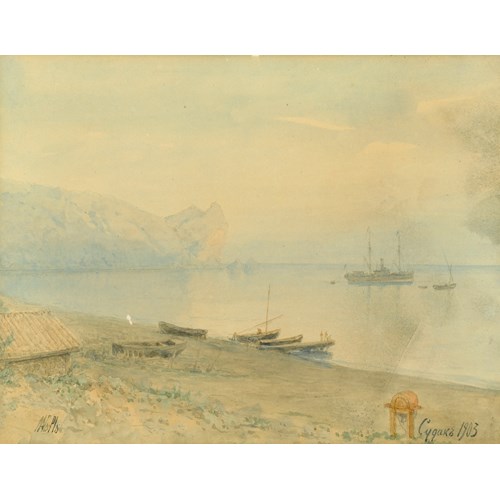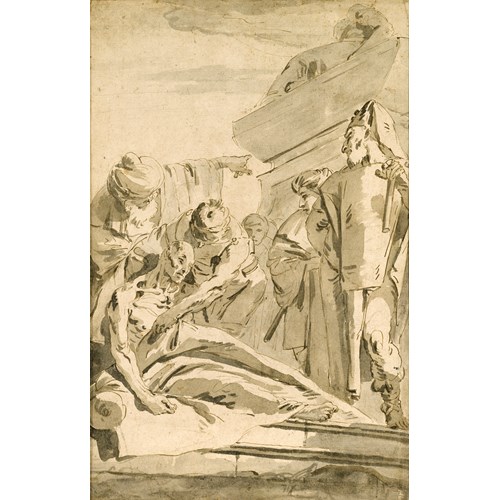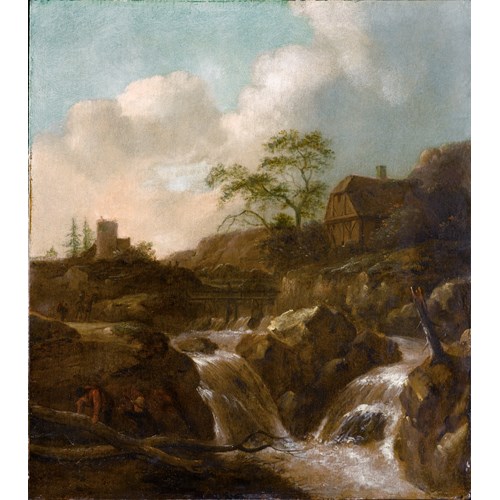Marketplace
Bathsheba Attended by Two Women
Domenico Piola
Bathsheba Attended by Two Women
Period 1600-1750, 17th century
Origin Italy
Medium Pen, Brown ink, Brown wash, Black chalk
Dimension 28.2 x 42.1 cm (11¹/₈ x 16⁵/₈ inches)
‘And it came to pass in an eveningtide, that David arose from his bed, and walked upon the roof of the king’s house: and from the roof he saw a woman washing herself; and the woman was very beautiful to look upon.’
- II Samuel 11:2
Married originally to Uriah the Hititte, the story of Bathsheba’s seduction by King David is told in II Samuel. While walking on the roof of his house, the King caught sight of her bathing and sent messengers to bring her to him. He then seduced her and made her pregnant. In an attempt to conceal his sin David summoned Bathesheba’s husband, Uriah, back from the army that he was away commanding in the hope that he would re-consummate his marriage to Bathsheba and assume the child already conceived to be his own. Uriah, however, elected to stay with his men rather than return home to his wife. After repeated efforts to convince Uriah to lie with Bathsheba, the king gave orders to his general Joab that Uriah be abandoned in the midst of a fierce battle and left to die at the hands of the enemy. Ironically, David had ordered Uriah himself to bear the message that ultimately led to his death. With Uriah dead, David made the now widowed Bathsheba his wife.
In his characteristically detailed style, Domenico Piola has captured the moment at which Bathsheba is completing her toilet with the assistance of her two handmaidens. He has faithfully transposed the well-known biblical scene into a contemporary Italian palazzo. Bathsheba, correspondingly, is portrayed as a high-born Italian woman reclining back on a plump, tasselled cushion. The accoutrements of her toilet, the perfume bottle and jewellery, lie casually on an ornate Baroque table decorated with gargoyles. Dominating the left foreground of the composition is an opulently carved urn filled with flowers. In faint outline, a building can be seen in the distance which, in many other renditions of the same subject matter, represents the roof from where David spied her. Often he is pictured, but in this drawing he is absent. It is possible that if this were a preparatory sketch for further work, David would be added in later. Indeed a painting of this subject with many of the same elements, but differing in composition, is in a private collection in Genoa.¹
Piola, a prolific draughtsman, designed many prints and frontispieces for books. He was also an outstanding painter and the leading artist in Genoa in the second half of the seventeenth century, designing and executing ceiling frescoes for an astonishing number of Genoese churches and palaces. He derived his mature style in part from Giovanni Benedetto Castiglione (1609-1664), whose influence is very much in evidence from the undulating figures and diagonal composition of this present drawing. Piola also responded to the echoes of Parmigianino’s (1503-1540) style that he found in the works of Valerio Castello (1624-1659).
¹ Sanguineti, D., Domenico Piola e i pittori della sua ‘casa’, Soncino 2004, vol. II, pp. 318, 408, no. I.94, reproduced pl. XLVIII.
- II Samuel 11:2
Married originally to Uriah the Hititte, the story of Bathsheba’s seduction by King David is told in II Samuel. While walking on the roof of his house, the King caught sight of her bathing and sent messengers to bring her to him. He then seduced her and made her pregnant. In an attempt to conceal his sin David summoned Bathesheba’s husband, Uriah, back from the army that he was away commanding in the hope that he would re-consummate his marriage to Bathsheba and assume the child already conceived to be his own. Uriah, however, elected to stay with his men rather than return home to his wife. After repeated efforts to convince Uriah to lie with Bathsheba, the king gave orders to his general Joab that Uriah be abandoned in the midst of a fierce battle and left to die at the hands of the enemy. Ironically, David had ordered Uriah himself to bear the message that ultimately led to his death. With Uriah dead, David made the now widowed Bathsheba his wife.
In his characteristically detailed style, Domenico Piola has captured the moment at which Bathsheba is completing her toilet with the assistance of her two handmaidens. He has faithfully transposed the well-known biblical scene into a contemporary Italian palazzo. Bathsheba, correspondingly, is portrayed as a high-born Italian woman reclining back on a plump, tasselled cushion. The accoutrements of her toilet, the perfume bottle and jewellery, lie casually on an ornate Baroque table decorated with gargoyles. Dominating the left foreground of the composition is an opulently carved urn filled with flowers. In faint outline, a building can be seen in the distance which, in many other renditions of the same subject matter, represents the roof from where David spied her. Often he is pictured, but in this drawing he is absent. It is possible that if this were a preparatory sketch for further work, David would be added in later. Indeed a painting of this subject with many of the same elements, but differing in composition, is in a private collection in Genoa.¹
Piola, a prolific draughtsman, designed many prints and frontispieces for books. He was also an outstanding painter and the leading artist in Genoa in the second half of the seventeenth century, designing and executing ceiling frescoes for an astonishing number of Genoese churches and palaces. He derived his mature style in part from Giovanni Benedetto Castiglione (1609-1664), whose influence is very much in evidence from the undulating figures and diagonal composition of this present drawing. Piola also responded to the echoes of Parmigianino’s (1503-1540) style that he found in the works of Valerio Castello (1624-1659).
¹ Sanguineti, D., Domenico Piola e i pittori della sua ‘casa’, Soncino 2004, vol. II, pp. 318, 408, no. I.94, reproduced pl. XLVIII.
Period: 1600-1750, 17th century
Origin: Italy
Medium: Pen, Brown ink, Brown wash, Black chalk
Dimension: 28.2 x 42.1 cm (11¹/₈ x 16⁵/₈ inches)
Provenance: J.A. Gere;
Hazlitt, Gooden and Fox, Ltd., London;
acquired in 1994 by Jeffrey E. Horvitz.
More artworks from the Gallery









